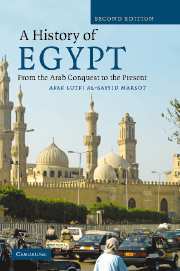Book contents
- Frontmatter
- Contents
- List of maps
- Preface
- Map 1 Egypt and its neighbours
- Map 2 Medieval Cairo
- 1 The Arab conquest of Egypt to the end of the Ayyubi dynasty, 639–1250
- 2 The age of the mamluks, 1250–1516
- 3 The Ottoman age, 1516–1805
- 4 The beginning of the state system, 1805–1922
- 5 The liberal experiment, 1922–52
- 6 The Nasser years, 1952–70
- 7 From Sadat to Mubarak, 1970 to the present day
- Select bibliography
- Index
5 - The liberal experiment, 1922–52
Published online by Cambridge University Press: 05 June 2012
- Frontmatter
- Contents
- List of maps
- Preface
- Map 1 Egypt and its neighbours
- Map 2 Medieval Cairo
- 1 The Arab conquest of Egypt to the end of the Ayyubi dynasty, 639–1250
- 2 The age of the mamluks, 1250–1516
- 3 The Ottoman age, 1516–1805
- 4 The beginning of the state system, 1805–1922
- 5 The liberal experiment, 1922–52
- 6 The Nasser years, 1952–70
- 7 From Sadat to Mubarak, 1970 to the present day
- Select bibliography
- Index
Summary
When the British government issued a unilateral declaration of Egyptian independence in 1922 they reserved four points of contention for future negotiations. These were: the defence of Egypt against foreign aggression or interference; the security of the communications of the British empire (that is the Suez Canal); the protection of foreign interests and of minorities; and the Sudan and its status.
A caretaker cabinet organized general elections, while the constituent committee, composed of the best legal brains, began preparing the ultimate constitution. Saad Zaghlul and his companions were released from exile in the Seychelles and returned to campaign for the elections. Their opponents, who had once been members of the Wafd – by now a political party – but had disagreed with Zaghlul's authoritarian style, formed a party of their own, the Liberal Constitutionalists (al-Ahrar al-Dusturiyyun).
The constituent committee was to meet with problems early on, as King Fuad, who was an autocrat, did not anticipate a constitution that would limit his authority or would even have strong powers of enforcement. The members of the constituent committee held the opposite view. The document that finally emerged was a compromise between the ideal and the real; it was a defective constitution, but the king refused to sign any other and was backed by the British government. The constitution vested legislative power in the king and a bicameral parliament. The king chose and appointed the prime minister and could dismiss the cabinet and postpone and prorogue parliament.
- Type
- Chapter
- Information
- A History of EgyptFrom the Arab Conquest to the Present, pp. 98 - 126Publisher: Cambridge University PressPrint publication year: 2007



